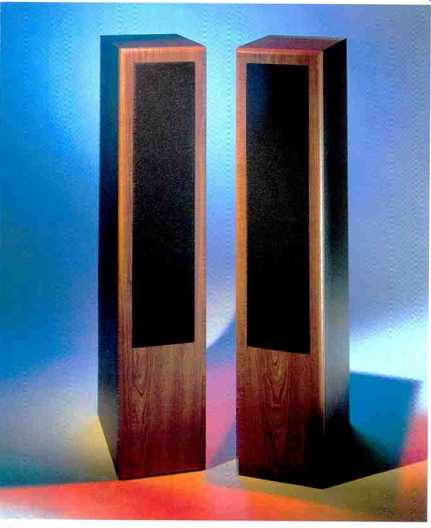
Manufacturer's Specifications:
Rated Frequency Response: 32 Hz to 22 kHz, ±3 dB.
Rated Sensitivity: 90 dB at 1 meter, 1 watt applied.
Rated Impedance: 4 ohms, nominal.
Rated Power Handling 175 watts, peak.
Dimensions: 41 3/8 in. H x 8 3/8 in. W x 14 1/2 in. D (105.1 cm x 22.5 cm x 36.8 cm).
Weight: 52 lbs. (23.6 kg) each.
Price: $999 per pair.
Company Address: 25 Walpole Park South, Walpole, Mass. 02081; 800/962-7757 or 508/668-8973; mbquart@tiac.net
The German company MB Quart's speaker offerings in the American market have changed considerably since I reviewed the 490MCS for the February 1992 issue. Until late 1995, MB Quart designed and manufactured all its speakers in Germany. Now most of the speakers the company sells in the U.S. are built here, using drivers made in Germany. (MB Quart's car and in-wall speakers, headphones, and a few other products are still imported.) Its American-made Domain series comprises nine models, a mix of bookshelf, tower, center-channel, and surround speakers plus two active sub woofers; prices range from $299 to $999 per pair.
The most expensive of these-in fact, the highest-priced speaker MB Quart offers in the U.S.--is the Domain D55, a 2 1/2-way tower having two 6 1/2-inch cone woofers and a 1-inch dome tweeter. The drivers are flush-mounted and arranged vertically, with the tweeter centered between the two woofers. This is not, however, a symmetrical D'Appolito configuration in which both woofers handle the same frequencies. The D55's bottom woofer, which has a vented enclosure, operates only up to 120 Hz; the top woofer, which has a sealed enclosure, operates up to 2.9 kHz, where the tweeter takes over. Below 120 Hz, both woofers operate together. Just below the bottom woofer is its long, 10-inch port tube, 3 inches in diameter and flared at each end, which tunes that woofer and enclosure to 38 Hz.
The D55 and most of the other Domain speakers have handsome cabinets with black grilles set into furniture-quality front panels and black vinyl sides and tops. Each front panel and grille comes off as a unit, which you can replace. Panels are available in 10 finishes, including traditional and exotic woods, piano black, and Prime (which you can stain, paint, or wallpaper). Because it's easier to stock front panels in various finishes than entire speakers, this system enables MB Quart to offer a wide variety of finishes and enables you to change a speaker's finish as your decor or taste changes.
The D55's removable front panel is built of 3/4-inch medium-density fiberboard, which makes it very heavy and substantial, and is covered with veneer. It attaches to the front of the cabinet via six heavy-duty thin pegs. The grille frame is treated with absorptive foam below the tweeter, to decrease reflections and reduce diffraction. The rest of the cabinet is also built very solidly, using a combination of medium- and high-density fiberboard. Its interior is divided into three cavities by two shelves. The top shelf, 91 inches below the top, forms a closed cavity for the upper woofer. The compartment between this shelf and the other one, which is 11 inches above the cabinet's bottom, forms the lower woofer's vented enclosure. Interestingly, the bottom chamber, below the second shelf, contains only the input-connection cup and contributes nothing to the speaker's bass.
The D55's two 6 1/2 inch woofers have treated fiber cones, butyl rubber surrounds, long-throw voice coils, and strong ferrite magnets that are 3 1/2 inches in diameter. The tweeter's 1-inch titanium dome is covered by a black screen with an integral phasing ring that smooths the driver's response and improves its coverage. (MB Quart also sells this tweeter to many high-end speaker manufacturers.)
The D55's crossover is on a single printed-circuit board, just behind the bottom woofer. The section feeding that woofer is a first-order low-pass filter, an inductor in series with the driver.
The top woofer is fed by a more complicated third-order low-pass filter comprising three inductors, two capacitors, and a resistor. There is also a series resistor-capacitor impedance compensation network in parallel with each woofer. The tweeter is connected to a third-order high-pass filter comprising an inductor, three capacitors, and a resistor. The smaller capacitors are high quality metallized-polyester film units; the larger inductors have laminated steel coil cores, the smaller ones air-core coils.
All internal connections use stranded, 16-AWG cable except for 18-AWG cabling to the tweeter. The cables are connected to the drivers by push-on terminals. On the rear of the D55 is a single pair of five way gold-plated binding posts with standard, 3/4-inch, spacing.
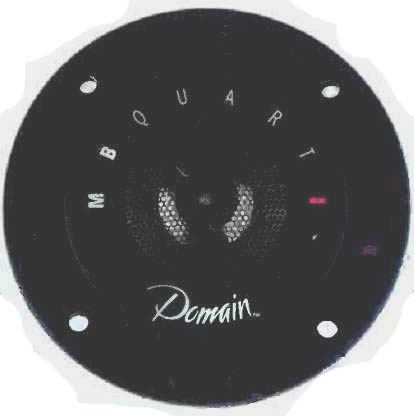
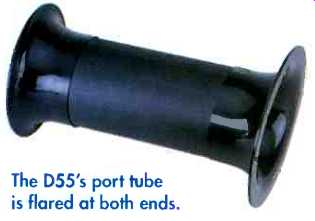

The D55's sides and rear are finished in a veneer of black vinyl.

The D55's port tube is flared at both ends.
Measurements
Figure 1 shows the MB Quart D55's frequency response, measured with and without grille in a large anechoic chamber. The measurements were taken at the height recommended by MB Quart, on the top woofer's axis. Over the wide range from 40 Hz to 20 kHz, the curve fits a fairly tight, 6-dB, window (+1,-5 dB, referenced to 1 kHz). Above 500 Hz, the grille causes significant deviations of about ±2 dB. Interestingly, the elevated region between 550 and 1,100 Hz is raised even more by the grille.
Averaged from 250 Hz to 4 kHz, the speaker's sensitivity measured 89.9 dB SPL at 1 meter for a 2.83 volt input. I suspect, therefore, that MB Quart's virtually identical sensitivity rating of 90 dB is for the same input voltage (which corresponds to 1 watt into 8 ohms and 2 watts into the D55's rated impedance of 4 ohms) rather than the stated input of 1 watt (which would be only 2 volts rms at the rated 4-ohm impedance). Otherwise, there would be a 3-dB discrepancy between the manufacturer's rating and my measurement. The right and left speakers matched within a close ±1 dB except in the one-third octave centered at 1.3 kHz, where one speaker's output fell 3 dB below its mate's.
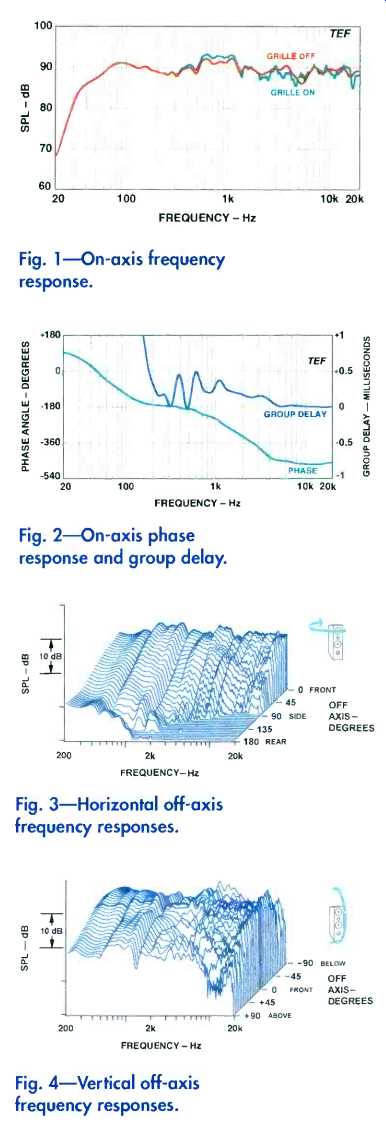
Fig. 1-On-axis frequency response.
Fig. 2-On-axis phase response and group delay.
Fig. 3-Horizontal off-axis frequency responses.
Fig. 4-Vertical off-axis frequency responses.

Fig. 5-Impedance magnitude (A) and phase (B).
Fig. 6-Three-meter room response.
Fig. 7-Harmonic distortion for E, (41.2 Hz).
Figure 2 shows the D55's phase and group-delay responses, referenced to the tweeter's arrival time. The phase curve falls continually with frequency to about-460° above 5 kHz, well into the tweeter's range.
The falling phase between 20 Hz and 5 kHz indicates that the acoustic output of the woofer/midrange slightly lags the tweeter's output; the amount of lag is proportional to the rate at which the phase slopes off with increasing frequency.
The group delay, which is calculated from the phase, indicates the rate at which the phase curve falls with frequency and hence the amount of lag, or delay, at each frequency. Ideally, lag would be constant at all frequencies, indicating that the speaker's acoustic output is aligned in time across the audio band and that its phase is linear with frequency. Such a phase curve would be a straight line if plotted on a linear frequency scale. The phase curves in this review, however, are plotted on logarithmic frequency scales so that the data can be plotted over a wide frequency band; on this scale, a straight phase curve does not imply a constant delay.
When averaged from 1 to 4 kHz, the group-delay curve in Fig. 2 indicates a relatively low offset of about 0.2 millisecond. The undulations between 300 Hz and 1.4 kHz are due mostly to minimum-phase peaks and dips in frequency response over this range. If response were equalized flat, these undulations would disappear.
The D55's horizontal on- and off-axis responses are shown in Fig. 3. (The bold, 0°, curve at the rear of the graph is on-axis response.) Although the response is a bit rough, the curve-to-curve uniformity attests to very even horizontal coverage. Between 20° and 50° off axis, the response has a high-frequency peak at 17.5 kHz (not clearly visible). Figure 4 shows the D55's vertical on- and off-axis responses. (The bold curve in the middle of the three-dimensional plot is on axis.) In the main vertical listening window, ±15°, the curves are mostly quite uniform except for a dip (not clearly seen) between 2 and 4 kHz, caused by cancelation at the 2.9 kHz crossover frequency. Even in this range, responses are quite uniform on axis and up to 10° above it, with the dip most prominent at 20° to 30° above and below the axis. As with the horizontal off axis responses, a 17.5-kHz peak in the tweeter's response occurs between 20° and 50° off axis.
The D55's impedance magnitude (Fig. 5A) has the two bass peaks (at 25 and 63 Hz) and a dip (at 38 Hz, the approximate tuning frequency) that are characteristic of vented enclosures. But you'll have to look closely to see that, because the impedance rise at 25 Hz is more of a bump than a peak.
The reason is that the D55's two woofers, one sealed and one vented, are connected in parallel up to 120 Hz. These parallel loads don't lower impedance much at 63 Hz, where both woofers' impedance peaks roughly coincide. The sealed woofer's impedance rolls off rapidly below its peak, however, becoming low enough by 25 Hz to swamp the vented woofer's lower peak.
The D55's impedance variation is a moderate 4.4 to 1 (13.2 divided by 3). Thus, cable resistance should be limited to a maximum of about 0.045 ohm if you want to keep cable-drop effects from causing response peaks and dips greater than 0.1 dB. For a typical run of about 10 feet, that would imply 12-gauge (or larger), low-inductance cable.
The D55's impedance phase (Fig. 5B) reaches its maximum, +46.3°, at 50 Hz and its minimum, -41.5°, at 80 Hz. A single D55 per channel should not be a difficult load for any competent amplifier.
The speaker's cabinet is fairly solid. A high-level sine-wave sweep caused minimal vibration except in a frequency band near 285 Hz, where the side and rear walls of the middle chamber vibrated. (If you look again at Figs. 5A and 5B, you'll see minor impedance anomalies at this frequency.) The D55's woofers overloaded quite gracefully when overdriven. Their maximum excursion was about 1 inch, peak to peak. I noted a significant amount of dynamic offset here and in the later tests of peak power. In one of the speakers, the woofers displaced in opposite directions when driven at high levels, the top one moving in and the bottom one moving out.
As is typical of closed-box enclosures, the top woofer's excursion increased as frequency decreased, reaching its maximum at about 50 Hz and staying there at lower frequencies. The excursion of the bottom woofer reached a sharp minimum at 38 Hz, the vented-box tuning frequency, and there was little chuffing from the port. The bottom woofer's excursion was less than the top woofer's from 55 down to 32 Hz but was greater below 32 Hz.
The D55's 3-meter room response, raw and smoothed, is shown in Fig. 6. The speaker was in the right-hand stereo position; the test microphone was at ear height (36 inches) at the listener's position on the sofa. From 700 Hz to 20 kHz, the averaged curve fits a fairly tight, 9-dB, window.
Above 4 kHz, in the tweeter's range, the curve fits a very tight, 2.5-dB, window. Between 250 Hz and 1.7 kHz, the averaged curve undulates significantly, with peaks at 530 Hz and 1.3 kHz and dips at 410 and 605 Hz.
Figure 7 shows the D55's E1 (41.2-Hz) harmonic distortion.
The second harmonic rises to a moderate 6%, while the third rises to a fairly high 18.8%. Higher harmonics are below 1.5%. At 75 watts, the top, closed-box, woofer's excursion at 41.2 Hz was quite high, accounting for a significant portion of the third-harmonic distortion. When I re-measured distortion with the top woofer disconnected, the third-harmonic distortion dropped to less than 11% (the second harmonic remained at about 6%). At 1 meter in free space and with a 75-watt input, the D55 generated a quite usable 105 dB SPL at 41.2 Hz.
Figure 8 shows the D55's A2 (110-Hz) harmonic distortion.
The second harmonic rises to a fairly high 16.8%, the third rises only to 4%, and higher harmonics are less than 1.4%. Distortion remains quite low below 20 watts.
Above 20 watts, the speaker started sounding somewhat harsh.
Figure 9 shows the IM distortion versus power, created by 440-Hz (A4) and 41.2-Hz (E1) tones of equal power. The IM distortion rises gradually, reaching 3.7% at 10 watts, 10% at 25 watts, and a quite audible 21% at 75 watts.
The D55's short-term peak power input and output are shown in Fig. 10. The peak input power starts at 22 watts at 20 Hz, and then it rises quickly to 180 watts at 43 Hz, which is near the vented-box resonance. After a slight fall it then rises again, leveling off at about 3.7 kilowatts above 1.4 kHz.
With room gain, the D55's peak output starts fairly high, 90 dB SPL, at 20 Hz; it then rises very rapidly, passing through 110 dB at 34 Hz before its slope diminishes, ending up at around 125 dB above 600 Hz.
The D55's bass output is above average for the speakers I have tested for Audio.
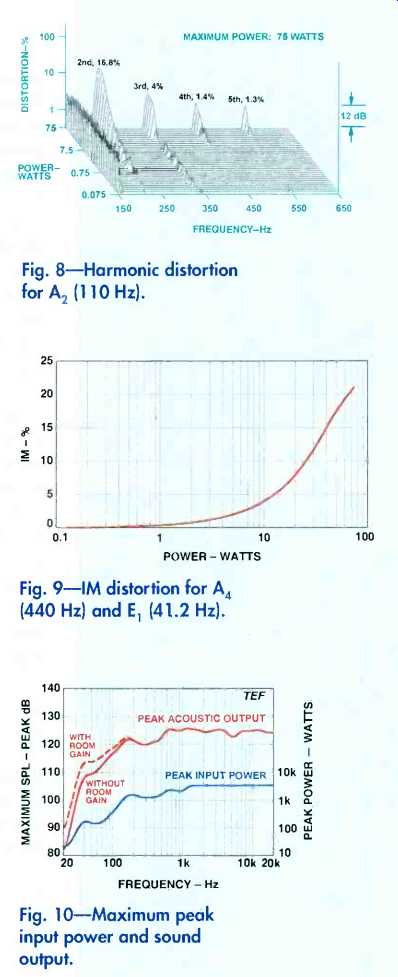
Fig. 8-Harmonic distortion for A2
(110 Hz).
Fig. 9-IM distortion for A4 (440 Hz) and E1 (41.2 Hz).
Fig. 10-Maximum peak input power and sound output.
Use and Listening Tests
I normally have no say about the cabinet finishes on the speakers I get for review. Sometimes I get whatever finish is handy, or I get plain black (possibly because speakers can get scratched up when they're moved around a lab for testing). So it was refreshing to be asked what finish I wanted on the MB Quart Domain D55s. From the many choices available, I selected oak, which was very attractive.
I was surprised that no manual was packed with the D55s, but that turned out to be deliberate. All Domain speakers are packed without manuals, because MB Quart intends buyers to get any necessary advice from their dealers. To that end, the company has a comprehensive dealer training program. I was sent some of the dealer training material, which goes into detail on speaker placement, room acoustics, and related matters. It was primarily home theater oriented and specifically recommended placing the D55s well away from room boundaries and not locating them close to a TV, because these speakers have no magnetic shielding. (MB Quart recommends the shielded D30 bookshelf speakers for use near a TV.) I listened to the D55s in a conventional stereo listening setup, with their grilles off. I placed the speakers 21 feet from the side walls and 4 feet from the wall behind them, just about what MB Quart recommends.
Small spikes, which screw into the bottom of each speaker, are supplied, but I did not use them. Associated listening equipment included a Krell KRC preamp driving a Crown Macro Reference power amplifier, with B&W 801 Matrix Series 3 speakers for comparison.
My first impression was extremely positive. The D55s sounded lively and dynamic, with strong bass, smooth and extended highs, and broad, even coverage.
The D55s did an excellent job of bringing out the subtleties of Ronn McFarlane's fingering in his lute playing on A Distant Shore (Dorian DOR-90242). Bach's Suite in E Major, a favorite of mine, was particularly well rendered; the voicing and overall tone were quite similar to what I heard on the B&W 801s.
On the more dynamic cuts by the dmp Big Band on the Glenn Miller Project (dmp CD-519), the D55s sounded clean and open, with minimal compression or congestion on loud horn passages. Bass was smooth and extended. The vocals and percussion on " Pennsylvania 6-5000" were quite effective and very realistic. (Incidentally, this excellent CD is encoded in Circle Surround but also sounded very impressive played in Dolby Surround on my home theater setup.) The D55s were quite sensitive, requiring only one-third as much power as the B&Ws for the same sound levels. That's like getting a new amplifier with three times the power for free! When reproducing pink noise, the Domain D55s' overall character and tonal balance were quite similar to the B&Ws' while I was seated. But when I stood up, there were definite upper-midrange differences between the two systems. In comparison, the B&Ws' nearly perfect vertical coverage maintained the same sound whether I was seated or standing.
On third-octave band-limited pink noise, the D55 provided no usable fundamental output in the 20- and 25-Hz bands.
At 32 Hz, however, its output was quite usable and fairly clean; from 40 to 80 Hz, the output was quite strong and clean but began to sound somewhat harsh when turned up loud, especially at and below 50 Hz (where the top woofer's displacement was greatest). On pipe organ music that had heavy bass pedal notes, the D55s delivered extended and wall-rattling response. However, the D55's extreme low end was not quite as robust as that of the B&W speaker (which is among the best bass reproducers) and did exhibit some intermodulation when the deep pedal notes were accompanied by higher frequencies.
The D55s handled male and female vocals with equal ease, sounding open, honest, and faithful to the originals. These qualities were evident in the speakers' clean, clear, and effortless reproduction of the female duet on "Cancion," from the Clarity Sampler (Clarity Recordings CCD-1010, a favorite demo disc of mine). The wood-block percussion on this track was particularly realistic. The D55s were equally at ease playing massed choral music, though some midrange tonal differences and a slight high-frequency emphasis made them sound very slightly hollow when compared with the B&Ws. On loud rock and country music, the D55s reached party levels with ease and delivered tight, gut-thumping bass.
On wide-range classical symphonic music, imaging and soundstaging were excellent. Center images on mono material were stable and appropriately narrow.
MB Quart's Domain D55s are excellent all-around sonic performers. They have fine looks, and their price is quite reasonable.
The interchangeable grille frames are attractive, and it's great to have the choice.
The D55s will perform equally well as stereo speakers or as main speakers in a home theater. They demand serious attention from anyone desiring a very good buy in loudspeakers.
-D. B. Keele, Jr.
(Adapted from Audio magazine, Jun. 1997)
Also see:
MB Quart 280 Speaker system (Equip. Profile, Dec. 1988)
Quart 490MCS Speaker (Feb. 1992)
Canton Ergo 100 Speaker (Mar. 1992)
= = = =